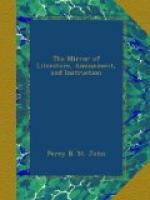GASPARD MONGE’S MAUSOLEUM.
[Illustration]
(To the Editor of the Mirror.)
Sir,—As one of your correspondents has favoured you with a drawing of the gaol I designed for the city and county of Norwich, with which you have embellished a recent number of the mirror, I flatter myself that an engraving from the drawing I herewith send you of the mausoleum of Gaspard Monge, which I drew while at Paris, in 1822, will also be interesting to the readers of your valuable little miscellany. Gaspard Monge, whose remains are deposited in the burying ground in Pere la Chaise, at Paris, in a magnificent mausoleum, was professor of geometry in the Polytechnique School at Paris, and with Denon accompanied Napoleon Bonaparte on his memorable expedition to Egypt; one to make drawings of the architectural antiquities and sculpture, and the other the geographical delineations of that ancient country. He returned to Paris, where he assisted Denon in the publication of his antiquities. At his decease the pupils of the Polytechnique School erected this mausoleum to his memory, as a testimony of their esteem, after a design made by his friend, Monsieur Denon. The mausoleum is of Egyptian architecture, with which Denon had become familiarly acquainted.
There is a bust of Monge placed on a terminal pedestal underneath a canopy in the upper compartment, which canopy is open in front and in the back. In the crown cavetto of the cornice is an Egyptian winged globe, entwined with serpents, emblematical of time and eternity; and on the faci below is engraved the following line:—
A. Gaspard Monge.
On each side of the upper compartment is inscribed the following memento mori:
Les ELEVES
de L’ECOLE Polytechnique.
A.G. Monge.
Comte de Peluse.
Underneath this inscription is carved in sunk work an Egyptian lotus flower in an upright position; on the back of the mausoleum is the date of the year in which Gaspard Monge died. The body is in the cemetery below.
An. MDCCCXX.
Monge was a man of considerable merit as a geometrician, and, while living, stood preeminent above his contemporaries in the French school of that day. He is the author of several works, but his most popular one is entitled “Geometrie Descriptive. par G. Monge, de l’Institut des Sciences, Lettres et Arts, de l’Ecole Polytechnique; Membre du Senat Conservateur, Grand Officier de la Legion d’Honeur et Cointe de l’Empire.”
The programme to this work is interesting, as it urges the necessity of making geometry a branch of the national education, and points out the beneficial results that would arise therefrom. The following is the translation:—




